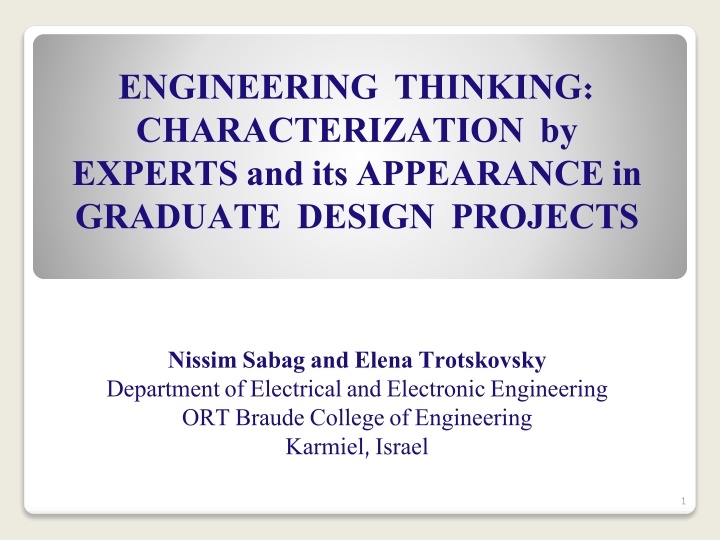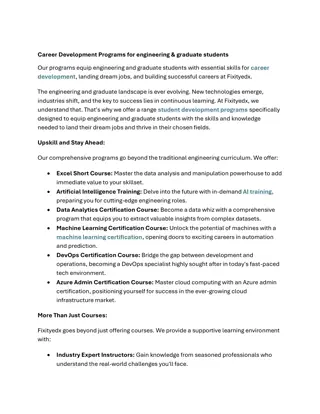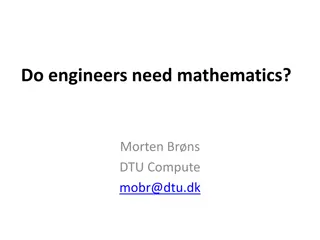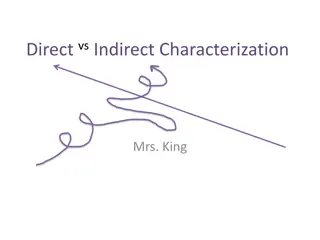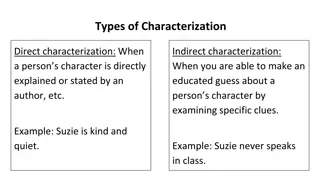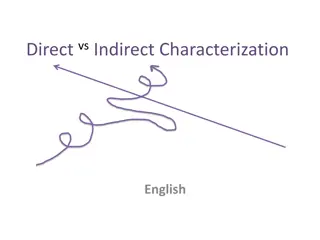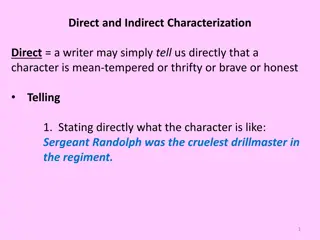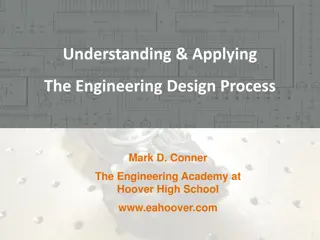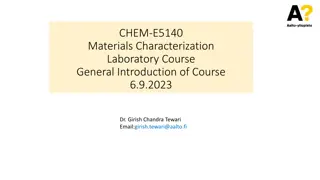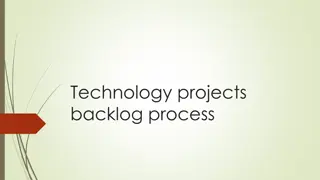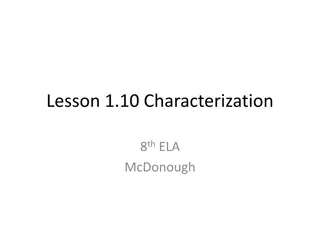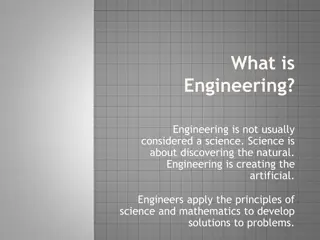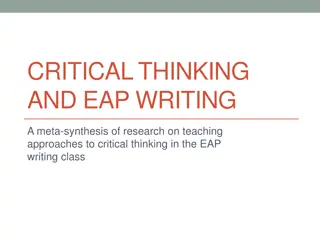Characterization of Engineering Thinking in Graduate Design Projects
Engineering thinking in project design is crucial for fresh engineering graduates. This study aims to characterize engineering design thinking through the perspective of experts and explore how undergraduate engineering students develop their own thinking processes while working on design projects.
Download Presentation

Please find below an Image/Link to download the presentation.
The content on the website is provided AS IS for your information and personal use only. It may not be sold, licensed, or shared on other websites without obtaining consent from the author.If you encounter any issues during the download, it is possible that the publisher has removed the file from their server.
You are allowed to download the files provided on this website for personal or commercial use, subject to the condition that they are used lawfully. All files are the property of their respective owners.
The content on the website is provided AS IS for your information and personal use only. It may not be sold, licensed, or shared on other websites without obtaining consent from the author.
E N D
Presentation Transcript
ENGINEERING THINKING: CHARACTERIZATION by EXPERTS and its APPEARANCE in GRADUATE DESIGN PROJECTS Nissim Sabag and Elena Trotskovsky Department of Electrical and Electronic Engineering ORT Braude College of Engineering Karmiel, Israel 1
Introduction : Engineering thinking in project design Fresh engineering graduates are involving in design of new artifacts. We use the name engineering design thinking to describe this kind of intellectual activity, which demands a specific type of thinking. Design thinking reflects the complex processes of inquiry and learning that designers perform in a systems context, making decisions , often working on teams in a social process, and speaking several languages with each other (Dym at all, 2005) 2
Introduction : Engineering thinking in project design (Cont.) It is important for educators in all areas of engineering to understand the nature of engineering design thinking. In order to reduce the gap between knowledge and skills acquired by novice graduates and market demands, it is advisable to develop engineering thinking already in the course of B.Sc. studies. This may help them to soften the transition from the academia to real work. 3
The internship program in the EEE Department of the Academic College for Engineering ORT Braude The internship is an obligatory requirement of the B.Sc. (in EEE) curriculum Includes engineering design project of 1,000 hours in an industry or research institute Two supervisors are assigned to each students, guiding him along his internship activities, one from the industry and the other from the academia 4
The Study aims to: Characterize engineering design thinking, from the experts point of view. Examine the thinking process of EEE undergraduate students while designing their project and developing their own engineering design thinking. An attempted to locate students intellectual activities in the experts' characterizations. 5
Method In the first part of our study we used quantitative tools ( a comprehensive questionnaire for graduates and their employers). For a deeper understanding of the cognitive processes, we switched to a qualitative research methodology: an interpretive research More than twenty in-depth interviews with experts (25 40 years of engineering experience, 13 of them have a Ph.D.) were conducted. Fifteen comprehensive interviews with students were conducted. The question for experts: How do engineers think in each stage of the design process? The question for students: How did you think in each stage of your design work? 6
Schematic Representation of the Research Categories System 1. Aims 5. Motivation for success 4. Environment 3. Thinking 2. Knowledge and tools 7
System of Categories Characterizes the Engineering Design Thinking Category Num. 1.1 Engineering Design Thinking Knowledgeapplication:directed to a new product 1. Aims 1.2 Engineering research: knowledge broadening for knowledge applications Engineering for research: knowledge application for knowledge broadening Creation of a knowledgebase 1.3 2.1 2.Knowledge and tools 2.2 Collecting and learning relevantknowledge 2.3 Mainly use of application models and laws 2.4 Using heuristics 8
System of Categories Characterizes the Engineering Design Thinking- cont. Category Num. 3.1 Engineering Design Thinking Synthesis, aspiring to understand how 3. Thinking 3.2 3.3 3.4 3.5 Concrete thinking Systems thinking Advance toward the desirable Optimal solution (Compromise on accuracy and adapting the term tolerance) Creative thinking and algorithmic routine thinking alternately Working mode: team work mainly Firm workingconditions Economicfacet is very significant Motivation:real need to succeed and individualresponsibility Appreciation:reputationin firm, patent 3.6 4.1 4.2 4.3 5.1 5.2 4. Environment 5. Motivation for success 9
Concrete Thinking Experts View Within a thinking process, the engineer translates the customer demands into system specifications to be designed. He chooses practical components with specific parameters to the system, connects and determines their working modes. He conducts a series of experiments to verify the system's functioning. It is evident that all these actions might be ascribed to concrete cognitive activities. An engineer must rely on existing entities using what already exists in development: materials, parts, components and known data [expert 5]. When you come to build systems you bring practical considerations to see if this thing can be built can we build it this way or that way. What other considerations should be taken to account ha not only mathematical. You should say can it be implemented? are the values reasonable? If I give it to production, can it be produced? Are there the needed tools and abilities? [expert 9] 10
Concrete Thinking Students findings As the experts testified, the engineering thinking consists of cognitive operations that can be considered as concrete operations. Example of concrete engineering thinking were expressed in students' work: When I am specifying a product I specify its features. Then I must close any corner. For example, the issue of manual operation: the user wants to open the valve, he opens it and goes. So, what now? Will the valve stay open forever? Will this valve close at midnight? Or, maybe, it will stop after a specified time? Another example refers to odd and even watering days in the U.S. If you are allowed to irrigate on an even day you get a big penalty. Now, what if a person starts his irrigation system on Monday at 11:00 P.M. and sets the system for 2 hours? Will the system stop at 12:00 P.M. or not? You must close this corner . [student 4] 11
Concrete Thinking Students findings (cont.) Mathematics it is more about hardware. You, mostly, do not need to rely on mathematics. It is simple to see the things. To see how things come together. To see the whole picture, what problems can be expected, what do you want to check and what is most important ? [student 8] It means, of course, that you have to test it (the system) in extreme situations: when it is loaded, when you do not have ideal conditions, with long supply lines, when some supply lines are close to each other, and you have situations that work well in the laboratory, but this is not real. This system can be 500 meters long from one side to the other. It is not like connecting a 10 meter cable and saying: fine, it is working ! [student 8] 12
Compromise on accuracy and adapting the term tolerance (experts testimony) "the engineer cannot expect pure pre-calculated accuracy in the operation of a designed set-up or process, because its ingredients and external conditions take values spread over externally imposed ranges (Waks,1994). Experts emphasized the importance tolerance and approximation in engineering design. Here are some examples: i. Engineering is blamed for "cutting corners". Engineering approximations are measured by sensitivity to end performance and justified by experience. ii. Scientific approximations are justified by the model sought [expert 8] 13
Compromise on accuracy and adapting the term tolerance (cont.) In engineering thinking, we move from an existing set of tools and seek a solution within the limits of accuracy. Yes, in the limits of accuracy or inaccuracy, I am saying it in purpose, I mean sufficient from the specifications point of view...I want to emphasize that the base is imprecision. Hamm An engineer's solution is never like a thin line. It always has some thickness. On the other hand, there are always tolerances and approximations, so engineering design mean compromising. The one who knows how to compromise and estimate variables more efficiently, is the one who gets a cheaper product [expert 4]. 14
Compromise on accuracy and adapting the term tolerance (students behavior) The resistor has 5% tolerance, so 5% it is. If you want to build a 300 kHz oscillator you might get 329 kHz. You must take it into consideration especially when it comes to capacitors. They have a standard tolerance of 10% and the temperature can make it to 20% or even 30%. So, it must be taken into consideration. To know that such things happen. [student 8] When I say a 51.94 ohms resistor, so what is the problem, it is only a number? Especially when we deal with a capacitor which has a standard tolerance of 10% and becomes worse with the temperature. You never see it during studying because it is all (studying) theoretical. [student 8] There are a lot of resistors. So, for self test purposes I defined 2.5 ohms instead of 1 ohm. It is the resistor's resistance plus the wire's resistance. There about 1.5 meters of wire, this has approximately 1.3 to 1.4 ohms. I determined it as a fact. So if the resistor shorts out I will see only 1.5 ohms and if it cuts out I will see a cut off. [student 7] 15
Creative thinking and algorithm routine thinking (experts) De Bono (1971) says: the design process involves much lateral thinking . Waks argues (1997) that lateral thinking is a form of creative thinking. And Voland (1999) claims that the creative thinking in design engineering involves the ability to combine things and ideas in new meaningful combinations. Here are some citations from the experts interviews: 16
Creative thinking and algorithm routine thinking (experts cont.) Need leads to thinking special needs yield deviation from norms. This is creative thinking that there is no compromising. [expert 4] It is like with artists, where does it come from? How does he create a picture or a piece of music? There is something unknown, unclear, some secret. He himself does not know how it comes out. I think that here is something in common between an artist and scientist. The engineer has it as well. [expert 15] His ability (the scientist) to jump from one subject to another and to look at the same problem from different points of view should be more developed. [expert 6] 17
Creative thinking and algorithm routine thinking (students) Here we bring examples of creative thinking among students. Whenever the student showed a nonstandard or original solution to his project problem, we classified it as creative thinking: One of the serious reasons that I created a coded controller is for "High Z". I want it to tell me who's on the BUS now, so others will not be able to reach it. This was one of the central problems. I could solve it without a controller. The controller is only to see who's on the BUS to avoid collisions. It just monitors the BUS and does not allow anyone to get the BUS till it's free . [student 5] The controller manages a dialog with you. That means, it asks yes or no questions and directs you according to this. The controller that I am developing now, it cost me my health; you don t need any manual to work with it. It will just ask you yes or no questions. After you answer yes, it will tell you: "use the + and keys to enter the watering time for valve one then press yes". After you press it will tell you: you did such and such . [student 4] 18
Integrative thinking One of the experts (above 30 years seniority), called the electronics industry today the industry of composition [expert 14]. Meaning, systems use components (entire blocks) that were developed for different goals by other manufacturers. The accessibility to information on the internet brings us to use products, ideas and solutions for specific engineering problems. In order to use these opportunities, an engineer should develop integrative thinking. A large part of the abilities today is evolution and the fact that you gather a lot of things from different sources, and connect them together to do something new. The thinking now is how to integrate things that I know and things that I need, and is this the most appropriate for me? Before, I had to break my head how will I build it, in order to implement it? Today I go and see what they did, if it helps me I will take it from there. The thought now is how do I integrate things that I know and things that I need and will it be the most suitable for me? [expert 9] 19
Integrative thinking (cont.) Electronic engineering today is playing LEGO if you know how to develop the LEGO. Take for example the issue of development today ha assuming they know the technology; they know the input and the output. They say: ok. I have the LEGO all the logic design is LEGO in digital electronics it's usually this way and digital electronics is about 70% - 80% of the whole electronics, in my opinion, it may not be exact. Actually you use you learn to use integrated circuits in the field of RF, that's the only difference. Take E. for example yes E. It is for many years a successful company. It had two or three things of their own, self developed, all the other products were, what we jokingly call, confectioned products. They took a system from R attached it let say to a sound system they joined it to an electro-optic system and fitted it to a product. Actually the project manager had to characterize the product according to is connections with the defense market, ok? What they did actually they stuck things together, ok, took from here and from there integrated it and made it an E.'s system. It's a pure LEGO even in principal every institute here works this way, not only digital electronics but electro-optics, RF, and other sophisticated systems as well. [expert 14] 20
Appearance of integrative thinking in students works I had two main lines. One is to design an assisting hardware for testing. Meaning, I had some purchased data acquisition to make the samples and so. From there it's not good enough; it works with its voltage levels. It sometimes has problems of loading so it needs some buffering. [student 8] The next citation refers to the economical aspects of using existing solutions when designing a new system: Once we went towards a SRU (buying a ready one) we decided to add some more options, such as PLLs. This was supposed to save us a lot of money. Today, we purchase it from National Instruments and say: let's save this money. The cost of developing such a SRU is 20,000$. So, since we already invested this money, it is better to use it (efficiently both now and in future projects). [student 5] 21
Conclusions In our efforts to understand the nature of engineering design thinking, we tried to characterize it. The way we approached this task included a set of interviews with experts from the field of EEE. In the second step of this research, we identified those characteristics in students' work while designing their first engineering project. Here we focused only on a few of the characteristics. As shown above, engineering thinking is concrete. It takes into consideration the customer needs, financial aspects, what already exists in the field and sufficient tolerances. Engineering thinking is composed of both creative and algorithmic routine thinking. In our opinion, educators should aim in both their curriculum and teaching efforts towards enhancing these abilities among their students. The appropriate environment for these activities might be the hi-tech industry where real engineering design is performed. 22
